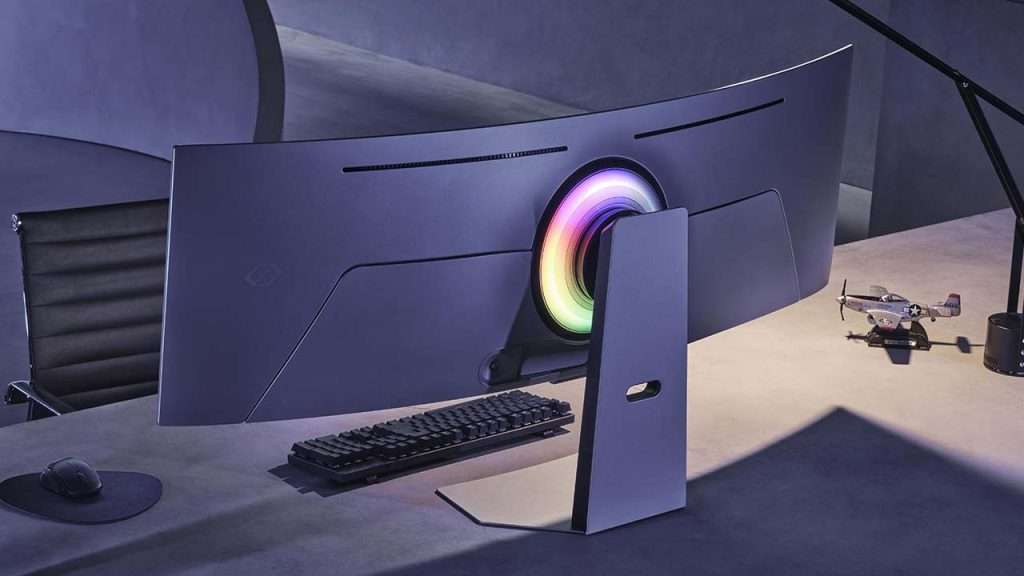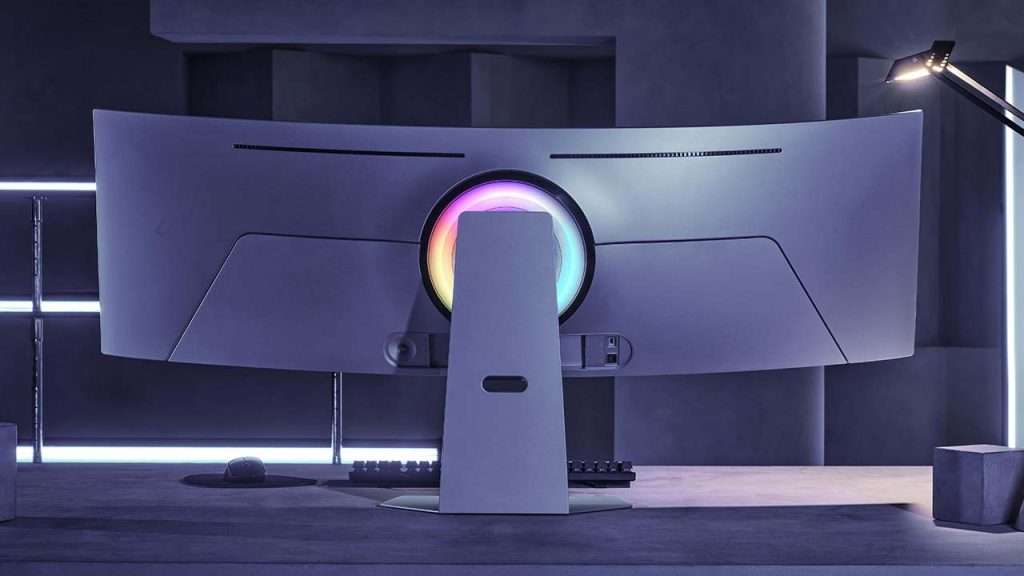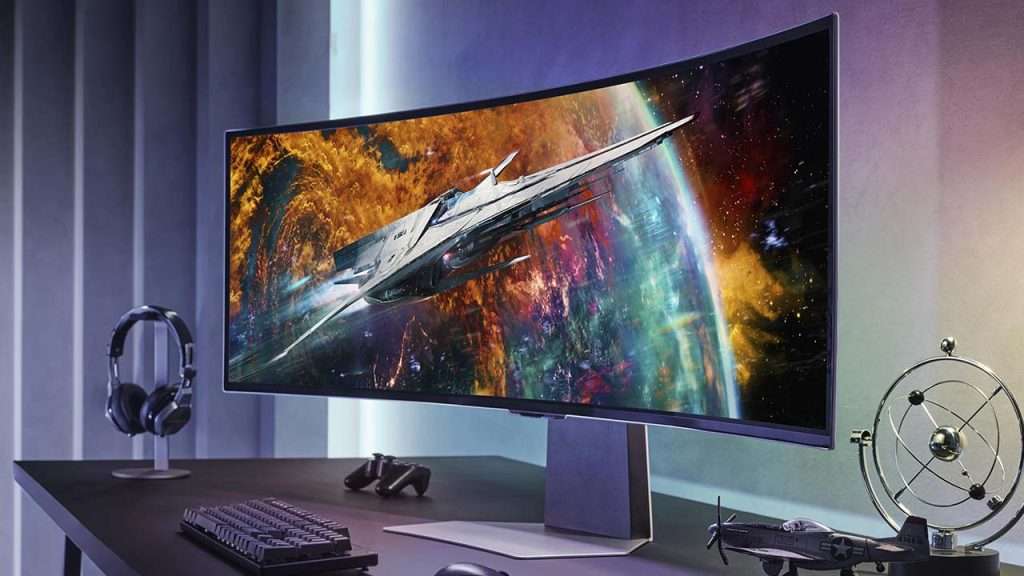The Samsung Odyssey OLED G9 (G93SC) is a premium gaming monitor with a premium price tag of $3299.
This massive 49-inch ultrawide monitor boasts the best of what the industry can provide. The 5120 x 1440 QD-OLED panel looks fantastic. The quantum dot technology included here allows the monitor to produce vibrant colours, brightness, and contrast, so visuals are rich and crisp, making gaming look brilliant. Combine that with the 240Hz refresh rate, and games are smooth even in intense action scenarios. But be warned; you’ll need a very powerful PC to get the most out of this monitor.
It’s hard to look past the Odyssey OLED G9 if you’re looking for an ultrawide monitor. However, it is disappointing that Samsung hasn’t introduced any advanced features with the G93SC model. This is a barebones ultrawide gaming monitor, which can’t do much more than act as a gaming monitor. And for $3299, I expected a bit more.
Pros
- 240Hz refresh rate
- Crisp, colourful QD-OLED display
- 49-inch display ideal for games that support ultrawide
Cons
- No advanced features
- Expensive
- Only 250nits brightness
Price
The 49-inch Samsung Odyssey OLED G9 (G93SC) costs $3299. To put this into perspective, the 45-inch 3440 x 1440 LG Ultragear 240Hz OLED Monitor costs $3,450.
Compared to other ultrawide monitors, the OLED G9 is competitively priced but is still significantly more expensive than a standard 4K monitor. As a comparison, the 32-inch, 3840 x 2160 MSI Optix 144Hz Gaming monitor costs $2,000.

Design
Like its predecessors, the Odyssey OLED G9 is a 49-inch monitor. It’s massive, and you’ll need a big desk to accommodate its width. Setting up the monitor did require some pre-planning, but it was surprisingly easy. The stand isn’t massive – taking up roughly the same amount as the one on my standard 32-inch screen – and I found it easy to place.
The OLED G9 boasts a 1800R curve, which means it has less curvature than the 1000R Samsung Odyssey Neo G9. I much prefer the 1000R model. It wraps around more, and being able to look directly at details on the edges is better for working and gaming. With the 1800R curvature, sometimes, I had to slide my head across the monitor instead of turning my head to see finer details. It still provides a good enough viewing angle most of the time, but the shallower curvature didn’t feel as comfortable as the 1000R monitor.
The back of the monitor is very similar to its predecessor. It looks futuristic with space-like designs and RGB lighting that lights up when you turn it on. Samsung calls this CoreSync and Core Lighting+. You can match the RGBs to the colours on the screen, adding a certain level of immersion. The lights weren’t bright enough to make any impact during the day, but in darker environments, the lights spread against the wall I had behind the display. It’s a nice touch.
The monitor has 2x USB-C ports, 1x USB-C PC Port, 1x Display Port (1.4), 1x HDMI port (2.1), 1x MicroHDMI (2.1) port and a port for power. The power cable has a massive power brick on it. You’ll need to have that sitting on something as it’s too heavy to hang. It was a bit of a nuisance, but I managed to tuck it away underneath the monitor easily enough.

Display
This is a 5120 x 1440 OLED display, which means it’s a dual quad high-definition screen with a 32:9 ratio. The monitor utilises Samsung’s QD-OLED technology which aims to deliver better colour accuracy, brightness and contrast when compared to a standard OLED display. It does this by using quantum dots – tiny particles known for producing highly saturated and vibrant colours. These dots generate a more colourful image, allowing the OLED G9 to produce darker blacks, reducing gloom when dark colours are next to light colours and improving accuracy.
The results are very impressive. Playing games and watching videos look fantastic on this screen. Colours are rich and crisp, and motion is smooth and accurate. It looks excellent.
The monitor supports DisplayHDR True Black 400 for vivid colours in HDR mode and has an average brightness of 250nits. This is a long way off the 2000nits in the Quantum Mini-LED Odyssey Neo G9.
One of the best features of a display this wide is the ability to open multiple windows next to each other. I could comfortably open four different programs and have them sit beside each other with Windows Snap layouts. It increased productivity was a comfortable experience.
The OLED G9 has pixel per inch (PPI) value of 108. This measures how many pixels are packed into each inch of the display. To put this into perspective, my 3840 x 2160, 32-inch screen has a PPI value of 137. A higher PPI means images and text look clearer and sharper, and I did notice text looked a bit blurry/fuzzy on the OLED G9. This was especially noticeable when viewing text on the sides of the display. I managed to alleviate this a little by changing the scale to 125% in Windows settings, but text didn’t look as crisp as my standard monitor.
The OLED G9 is at its best when playing a game or watching a movie that supports the ultrawide resolution. If the content you’re watching or the game you’re playing doesn’t support it, you’ll get big black bars on either side of the screen. These can be off-putting and jarrring.

Gaming
The OLED G9 is at its best with dedicated gaming hardware. This is a large screen, and the high resolution requires a powerful PC.
I played Microsoft Flight Simulator with my Nvidia 3090, and the experience was brilliant. The cockpit felt larger than ever, with each window on the sides of the screen wrapping around my head. This is the sort of game where the larger monitor thrives. Forza Horizon 5 was also a great experience.
I also tested Back 4 Blood and Sea of Thieves. Back 4 Blood allowed me to see more enemies in my surroundings, making the game feel more chaotic. However, Sea of Thieves doesn’t support ultrawide, so I couldn’t get that unique experience.
This is one of the main issues with an ultrawide monitor. While it isn’t necessarily Samsung’s fault, not everything will support ultrawide monitors. If a certain game doesn’t support the resolution, you’re forced to have it in a smaller area with huge black bars on either side. While this might not be a problem for some, I didn’t like it. It looks odd.
This is the same for watching films or videos and using some websites. YouTube, for example, doesn’t utilise the full width of the screen, and neither does Reddit. The content sits in the middle of the screen with large empty spaces on either side. It’s not ideal, and I much preferred using these websites and apps on my standard 32-inch monitor.
The 240Hz capabilities of the G9 are phenomenal, and it’s still one of the highest refresh rates you can get on a gaming monitor. However, be warned, if you’re playing games at max resolution, you’ll need a monster computer to get anywhere near 250 frames-per-second. I tested this monitor with my Nvidia 3090, and I struggled to get above 100fps even on games like Back 4 Blood, which isn’t as graphically demanding as Microsoft Flight Simulator or A Plague Tale: Requiem.
The monitor supports AMD FreeSync Premium Pro to prevent display lag, but there is no Nvidia G-Sync support here. This could be a deal breaker for someone using an Nvidia graphics card, and it’s disappointing, especially as the Odyssey Neo G9 has G-Sync support.
Verdict
The OLED G9 is an expensive $3299 monitor that doesn’t introduce many new features or functions besides the OLED screen. But it works well, enhances the gaming experience, and even makes multitasking during work much more manageable.
The impressive 5120 x 1440 QD-OLED panel uses Samsung’s quantum dot technology, enhancing colour accuracy, brightness and contrast, resulting in rich and crisp visuals whether gaming or watching videos. Its 240Hz refresh rate is market-leading, and the picture quality is impressive.
While I wasn’t as fond of the 1800R curve as much as the 1000R curvature found in the Neo G9, the low pixel-per-inch count meant text didn’t always look as sharp or crisp as I would’ve liked, and the lack of Nvidia G-Sync support will be off-putting for some, overall the experience was great, primarily when gaming.
If you have a powerful enough PC, games that support ultrawide provide an immersive experience that you can’t get with a standard monitor.
If you have the money and are looking for an ultrawide monitor, you’ll love the OLED G9.

